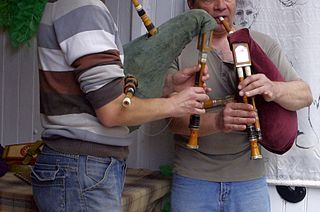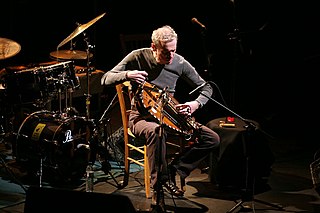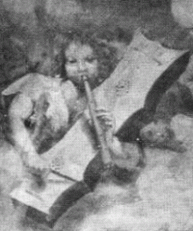Medieval metal is a subgenre of folk metal that blends heavy metal music with medieval folk music. Medieval metal is mostly restricted to Germany where it is known as Mittelalter-Metal or Mittelalter-Rock. The genre emerged from the middle of the 1990s with contributions from Subway to Sally, In Extremo and Schandmaul. The style is characterised by the prominent use of a wide variety of traditional folk and medieval instruments.

The hurdy-gurdy is a string instrument that produces sound by a hand-crank-turned, rosined wheel rubbing against the strings. The wheel functions much like a violin bow, and single notes played on the instrument sound similar to those of a violin. Melodies are played on a keyboard that presses tangents—small wedges, typically made of wood or metal—against one or more of the strings to change their pitch. Like most other acoustic stringed instruments, it has a sound board and hollow cavity to make the vibration of the strings audible.
In France, music reflects a diverse array of styles. In the field of classical music, France has produced several prominent romantic composers, while folk and popular music have seen the rise of the chanson and cabaret style. The earliest known sound recording device in the world, the phonautograph, was patented in France by Édouard-Léon Scott de Martinville in 1857. France is also the 5th largest market by value in the world, and its music industry has produced many internationally renowned artists, especially in the nouvelle chanson and electronic music.

Zampogna is a generic term for a number of Italian double chantered bagpipes that can be found as far north as the southern part of the Marche, throughout areas in Abruzzo, Latium, Molise, Basilicata, Campania, Calabria, Apulia and Sicily. The tradition is now mostly associated with Christmas, and the most famous Italian carol, "Tu scendi dalle stelle" is derived from traditional zampogna music. However, there is an ongoing resurgence of the instrument in secular use seen with the increasing number of folk music festivals and folk music ensembles.
Northwest Iberian folk music is a traditional highly distinctive folk style, located along Spain's north-west Atlantic coast, mostly Galicia and Asturias, that has some similarities with the neighbouring area of Cantabria. The music is characterized by the use of bagpipes.
Bal-musette is a style of French instrumental music and dance that first became popular in Paris in the 1880s. Although it began with bagpipes as the main instrument, this instrument was replaced with accordion, on which a variety of waltzes, polkas, and other dance styles were played for dances.
The best known musician from the Occitan region of Limousin is probably the piper Eric Montbel, a former member of such bands as Lo Jai, Le Grand Rouge, and Ulysse; he plays the chabreta, or Limousin bagpipe. Along with him and other pipers, the region is known for Corrèze's distinct violin tradition as well as the hurdy-gurdy. The fife is also popular
Auvergne is a region in France. Its best-known form of folk music is that played on the cabrette, a bagpipe made of goatskin. This is used to play swift, 3/8 dance music, slow airs (regrets) and other styles. The traditional master Joseph Rouls taught many modern players, including Dominique Paris, Jean Bona and Michel Esbelin. Other styles of music include the shepherd's calls known as ballero.

The flabiol is a Catalan woodwind musical instrument of the family known as fipple flutes. It is one of the 12 instruments of the cobla. The flabiol measures about 25 centimeters in length and has five or six holes on its front face and three underneath.

French bagpipes cover a wide range and variety of styles of bagpipes and piping, from the Celtic piping and Music of Brittany to the Northern Occitan's cabrette.

The musette de cour or baroque musette is a musical instrument of the bagpipe family. Visually, the musette is characterised by the short, cylindrical shuttle-drone and the two chalumeaux. Both the chanters and the drones have a cylindrical bore and use a double reed, giving a quiet tone similar to the oboe. The instrument is blown by a bellows.

The cobla is a traditional music ensemble of Catalonia, and in Northern Catalonia in France. It is generally used to accompany the Sardana, a traditional Catalan folk dance, danced in a circle.
The following recordings and films feature music played on the hurdy-gurdy.

Dominique Regef is a French improvisor, composer, and musician specializing in stringed instruments: the cello, the rebec, the vièle à archet, and the Rajasthan dilruba. Dominique Regef is recognized as an exceptional soloist on the hurdy-gurdy; he is known for surprising and moving audiences with his sound on the instrument. His concerts, be it a solo recital or a small group performance, shock listeners from all over the world with their originality and their strength. He has performed in several well-known music festivals, including the International Baroque Music Festival, the Jazz à Luz festival and the Grenoble Jazz Festival. He is cited as one of the best examples of modern hurdy-gurdy playing.

The xeremia is a type of bagpipe native to the island of Majorca (Mallorca). It consists of a bag made of skin, known as a sac or sarró which retains the air, a blowpipe (bufador), a melody pipe or chanter (grall), and several, generally three, drones (bordons). The primary drone (roncó) sounds a tonic note, but the other drones are sometimes simply false drones for ornamentation.

Antoine ("Bousca") Bouscatel was a French cabrette bagpipe player, well-known at the turn of the 20th century in Paris.
The pipasso is a type of bagpipe found in northern France and Belgium. It is commonly called the "Picardy bagpipe". In the Belgian province of Hainaut, it is also known as the muchosa.

Ithilien is a Belgian folk metal band from Brussels using traditional folk instruments such as a hurdy gurdy, a bagpipe, a violin, a nyckelharpa, flutes and a bouzouki. They combine elements of metal (death/metalcore) and traditional folk music.
Traditional French musical instruments, known as instruments traditionnels in French, are musical instruments used in the traditional folk music of France. They comprise a range of string, wind, and percussion instruments.












